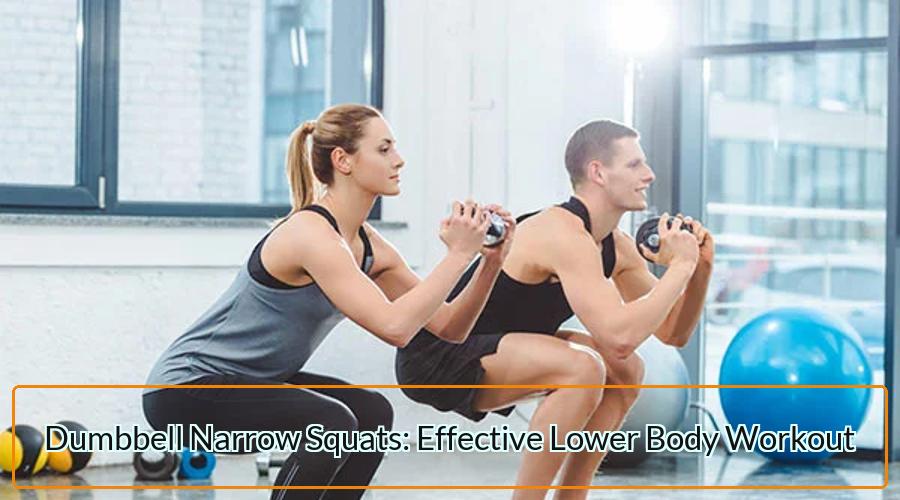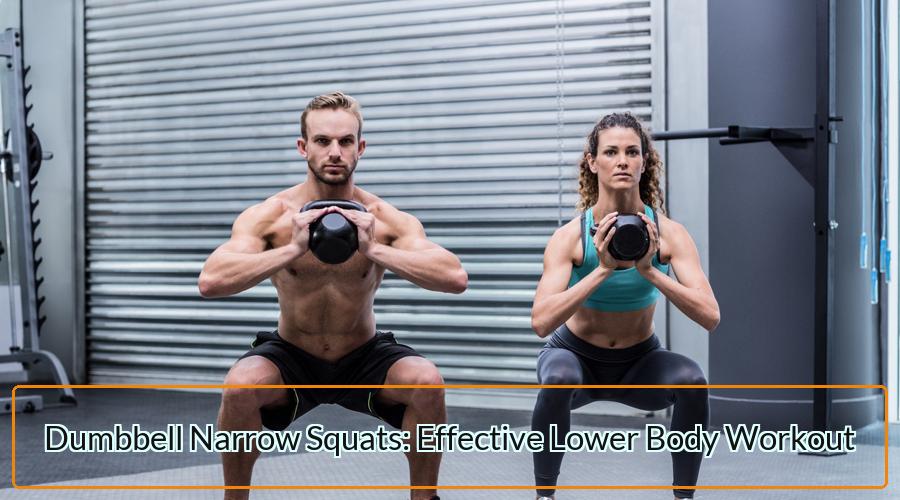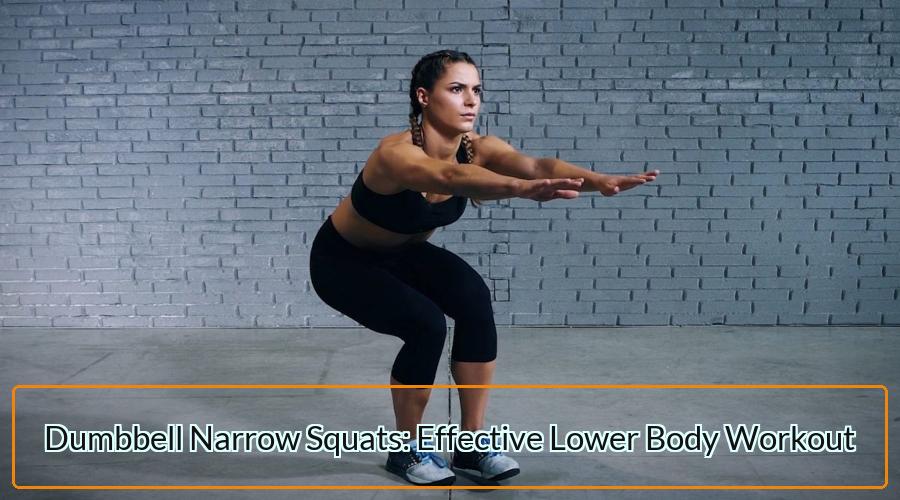
Are you looking to strengthen your lower body and build muscle? Dumbbell narrow squats could be just the exercise you need to achieve your fitness goals. By focusing on your glutes, quads, and hamstrings, this workout can help you tone and sculpt your legs while also increasing overall strength.
In this blog post, we’ll explore the benefits of dumbbell narrow squats in greater detail. We’ll discuss the correct form for performing this exercise, the muscle groups it targets, and how it can help you achieve your fitness goals. Whether you’re a beginner looking to add variety to your workout routine or a seasoned athlete seeking to take your lower body training to the next level, we’ve got you covered.
So, if you’re ready to learn more about this powerful exercise and discover how it can help you boost your lower body strength, then read on. Let’s dive in and explore the world of dumbbell narrow squats!
Importance of Lower Body Strength Training
Lower body strength training is an essential component of any well-rounded fitness routine. Strong legs, hips, and glutes not only provide a foundation for physical activity, but they also contribute to overall health and well-being. Here are some of the key reasons why lower body strength training should be a part of your workout regimen:
- Increased athletic performance and endurance: Strong lower body muscles are crucial for many sports and activities, from running and cycling to basketball and soccer. Regular lower body strength training can improve speed, power, and endurance, allowing you to perform better and go longer.
- Reduced risk of injury and improved joint health: Weak lower body muscles can contribute to poor posture, alignment, and balance, leading to increased risk of injury and joint pain. Lower body strength training helps to build and maintain strong muscles, bones, and connective tissues, which can improve overall joint health and reduce the risk of injury.
- Enhanced metabolism and weight management: The muscles of the lower body are some of the largest and most metabolically active in the body. Regular lower body strength training can help to increase muscle mass, which in turn boosts metabolism and improves the body’s ability to burn fat and calories.
- Improved overall balance and mobility: Strong lower body muscles are crucial for maintaining balance and stability, particularly as we age. Lower body strength training can improve overall mobility, coordination, and balance, reducing the risk of falls and other injuries.
So, whether you’re an athlete looking to improve your performance, or simply looking to improve your overall health and well-being, lower body strength training is a must. Incorporating exercises such as squats, lunges, deadlifts, and other lower body exercises into your fitness routine can help you build strong, functional muscles that support your overall physical health and fitness goals.
Read more about Trenbolone Pills for Sale
Benefits of Narrow Stance Squats
Narrow stance squats are a variation of traditional squats that involve a narrower stance, with the feet closer together. Here are some of the key benefits of incorporating narrow stance squats into your lower body strength training routine:
- Targets multiple lower body muscle groups: Narrow stance squats primarily target the quads, glutes, and hamstrings, but also engage the calves, core, and lower back muscles. This makes it a highly effective exercise for building strength and muscle in the lower body.
- Improves balance, stability, and mobility: Narrow stance squats require more balance and stability than traditional squats, as the narrower stance challenges the body to maintain proper alignment and control. This can improve overall balance and mobility, and help to prevent falls and injuries.
- Can help to correct muscle imbalances: Many people have muscle imbalances in their lower body, with some muscles being stronger or more developed than others. Narrow stance squats can help to correct these imbalances by engaging all of the muscles in the lower body more evenly.
- Can be customized to individual fitness levels: Narrow stance squats can be performed with bodyweight only, or with added weight in the form of dumbbells, barbells, or kettlebells. This makes it a versatile exercise that can be customized to the individual fitness level and goals of the user.
Incorporating narrow stance squats into your lower body strength training routine can be a highly effective way to build strength, muscle, and overall physical fitness. Whether you’re a beginner or an experienced athlete, this exercise can be customized to your individual fitness level and goals, making it a valuable addition to any workout routine.
How to Perform Dumbbell Narrow Squats
Performing dumbbell narrow squats is a great way to target your quads, glutes, and hamstrings, while also improving balance and stability. Here’s a step-by-step guide to performing dumbbell narrow squats with proper form:
- Start by standing with your feet shoulder-width apart, holding a dumbbell in each hand.
- Position your feet closer together so that they are hip-width apart or slightly narrower. Your toes should be pointed slightly outward.
- Hold the dumbbells with your palms facing inward and your arms at your sides.
- Engage your core muscles and keep your back straight as you begin to lower your body down into a squat position. Imagine that you’re sitting back into a chair.
- Keep your chest lifted and your knees in line with your toes as you lower down until your thighs are parallel to the ground.
- Pause briefly at the bottom of the squat, then push through your heels to return to the starting position.
- Repeat for the desired number of reps.
It’s important to maintain proper form when performing dumbbell narrow squats to avoid injury and maximize the benefits of the exercise. Here are a few tips to help you maintain proper form:
- Keep your chest lifted and your shoulders down and back throughout the movement.
- Keep your knees in line with your toes and avoid letting them collapse inward.
- Engage your core muscles to help stabilize your body and maintain proper alignment.
- Keep your weight in your heels as you lower down into the squat to avoid putting too much pressure on your knees.
- Start with a lighter weight and gradually increase the weight as you become more comfortable with the exercise.

Narrow Stance Squats vs. Traditional Squats
Narrow stance squats and traditional squats are both effective exercises for building lower body strength and muscle mass. However, there are some key differences between the two exercises that are worth noting. Here are a few of the main differences between narrow stance squats and traditional squats:
- Foot placement: The most obvious difference between narrow stance squats and traditional squats is the placement of the feet. In traditional squats, the feet are placed hip-width apart or slightly wider, while in narrow stance squats, the feet are placed hip-width apart or slightly closer together.
- Muscles targeted: Both exercises primarily target the quads, glutes, and hamstrings, but narrow stance squats tend to place more emphasis on the quads, while traditional squats tend to engage the glutes and hamstrings more.
- Balance and stability: Narrow stance squats require more balance and stability than traditional squats, as the narrower stance challenges the body to maintain proper alignment and control. This can be a good thing for improving overall balance and stability, but it can also make the exercise more challenging for some people.
- Range of motion: Narrow stance squats tend to have a slightly shorter range of motion than traditional squats, as the feet are closer together and the knees are less likely to track forward over the toes. This can make the exercise easier on the knees, but it may also make it less effective for engaging the glutes and hamstrings.
Overall, both narrow stance squats and traditional squats can be effective exercises for building lower body strength and muscle mass. The choice between the two exercises ultimately depends on personal preference, fitness level, and individual goals. It may also be beneficial to incorporate both exercises into a well-rounded lower body strength training routine.
Variations of Narrow Stance Squats
Variations of narrow stance squats can add variety to your lower body workout routine, target different muscles, and make your training more challenging. Here are three variations of narrow stance squats to consider:
- Alternating narrow stance squats: This variation involves alternating between left and right leg squats with a narrow stance. Start with your feet shoulder-width apart, then step your left foot back and to the right, so that your feet are hip-width apart or slightly closer together. Perform a squat, then return to the starting position and repeat with your right leg. This variation targets the quads, glutes, and hamstrings, as well as the calves and core muscles.
- Goblet squats with a narrow stance: Goblet squats involve holding a weight (usually a dumbbell or kettlebell) in front of your chest while performing a squat. With a narrow stance, this exercise can be particularly effective for targeting the quads and glutes. Hold the weight with both hands at chest height, and perform a squat with your feet hip-width apart or slightly closer together. This variation can also help to improve upper body posture and core stability.
- Bulgarian split squats with a narrow stance: Bulgarian split squats involve placing one foot on a bench or step behind you while performing a squat with the other leg. With a narrow stance, this exercise can be particularly effective for targeting the quads and glutes. Place the ball of your back foot on a bench or step behind you, and perform a squat with your front foot hip-width apart or slightly closer together. This variation can also improve balance and stability, as well as increase hip mobility.
Incorporating variations of narrow stance squats into your lower body workout routine can help you target different muscle groups, challenge your body in new ways, and prevent boredom or burnout. Try incorporating one or more of these variations into your next lower body workout for added variety and challenge.
Read more about Anavar in UK

Incorporating Narrow Stance Squats into Your Workout Routine
Incorporating narrow stance squats into your lower body workout routine can be a highly effective way to build strength, muscle, and overall physical fitness. Here are some tips for incorporating narrow stance squats into your workout routine:
- Start with bodyweight squats: If you’re new to narrow stance squats or lower body strength training in general, start with bodyweight squats to master the technique and build a solid foundation of strength and control. Once you feel comfortable with the movement, you can add weight in the form of dumbbells, barbells, or kettlebells.
- Incorporate narrow stance squats into your existing lower body routine: If you’re already doing lower body exercises like squats, lunges, or deadlifts, try incorporating narrow stance squats into your routine as a variation. This can help to target different muscles and prevent plateaus in your training.
- Use proper form and technique: It’s important to use proper form and technique when performing narrow stance squats to avoid injury and maximize the benefits of the exercise. Keep your chest lifted, your knees in line with your toes, and your weight in your heels as you lower down into the squat.
- Gradually increase weight and reps: As you become more comfortable with narrow stance squats, gradually increase the weight and reps to challenge your body and continue to make progress. However, make sure to listen to your body and avoid pushing yourself too hard, as this can lead to injury or burnout.
- Mix it up with other variations: As mentioned earlier, there are several variations of narrow stance squats that can add variety and challenge to your lower body workout routine. Consider mixing it up with other variations like alternating narrow stance squats, goblet squats with a narrow stance, or Bulgarian split squats with a narrow stance.
Incorporating narrow stance squats into your lower body workout routine can be a highly effective way to build strength, muscle, and overall physical fitness. By following these tips and incorporating proper form and technique, you can ensure that you’re getting the most out of this exercise and maximizing your results.
Tips for Maximizing Your Results
If you’re looking to maximize your results from narrow stance squats, here are some tips to consider:
- Maintain proper form: Maintaining proper form and technique is essential for getting the most out of narrow stance squats. Keep your chest lifted, your knees in line with your toes, and your weight in your heels as you lower down into the squat. This will ensure that you’re engaging the right muscles and avoiding injury.
- Increase weight and reps gradually: To continue making progress and challenging your body, gradually increase the weight and reps of your narrow stance squats over time. However, make sure to do so gradually and listen to your body. Pushing yourself too hard too quickly can lead to injury or burnout.
- Incorporate other lower body exercises: While narrow stance squats can be a highly effective exercise on their own, incorporating other lower body exercises like lunges, deadlifts, or step-ups can help to target different muscle groups and prevent plateaus in your training.
- Rest and recover: Rest and recovery are just as important as the exercise itself. Make sure to take rest days and prioritize sleep, hydration, and proper nutrition to allow your body to recover and rebuild between workouts.
- Challenge yourself: To continue making progress and seeing results, it’s important to challenge yourself and push yourself out of your comfort zone. Whether it’s increasing the weight, reps, or trying a new variation of narrow stance squats, keep pushing yourself to improve and reach new goals.
By following these tips, you can maximize your results from narrow stance squats and continue to improve your lower body strength, muscle mass, and overall physical fitness.
Conclusion
Dumbbell narrow squats are a highly effective exercise for building lower body strength, muscle mass, and overall physical fitness. By targeting the quads, glutes, and hamstrings, narrow stance squats can help to improve athletic performance, balance, stability, and mobility, while also contributing to weight management and overall health and well-being.
Incorporating narrow stance squats into your lower body workout routine can be a great way to challenge your body, prevent boredom or burnout, and reach new goals. By following proper form and technique, gradually increasing weight and reps, incorporating other lower body exercises, prioritizing rest and recovery, and challenging yourself, you can maximize your results and continue to make progress over time.
Overall, narrow stance squats are a valuable addition to any lower body strength training routine and can help you build strong, functional muscles that support your overall physical health and fitness goals. So why not give them a try and see what kind of results you can achieve?